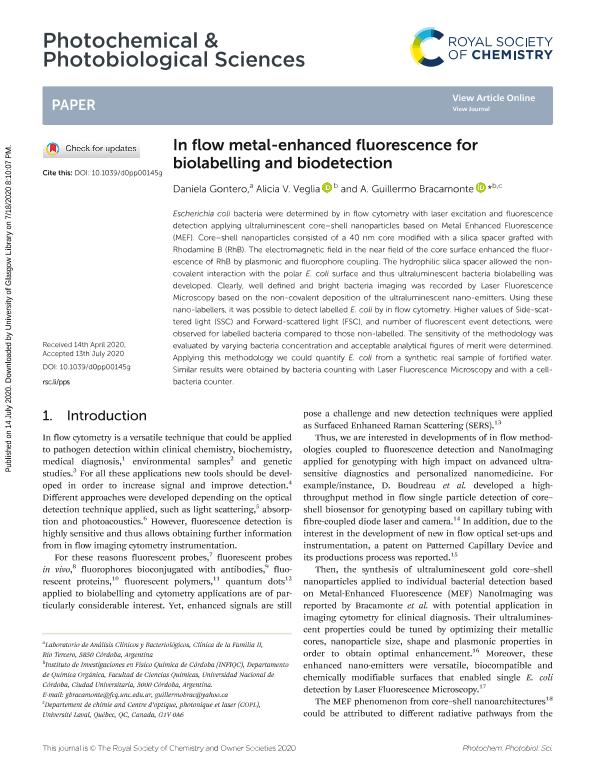Mostrar el registro sencillo del ítem
dc.contributor.author
Gontero, Daniela

dc.contributor.author
Veglia, Alicia Viviana

dc.contributor.author
Bracamonte, Angel Guillermo

dc.date.available
2021-10-19T23:16:26Z
dc.date.issued
2020-09
dc.identifier.citation
Gontero, Daniela; Veglia, Alicia Viviana; Bracamonte, Angel Guillermo; In flow metal-enhanced fluorescence for biolabelling and biodetection; Royal Society of Chemistry; Photochemical and Photobiological Sciences; 19; 9; 9-2020; 1-21
dc.identifier.issn
1474-905X
dc.identifier.uri
http://hdl.handle.net/11336/144364
dc.description.abstract
Escherichia colibacteria were determined by in flow cytometry with laser excitation and fluorescence detection applying ultraluminescent core-shell nanoparticles based on Metal Enhanced Fluorescence (MEF). Core-shell nanoparticles consisted of a 40 nm core modified with a silica spacer grafted with Rhodamine B (RhB). The electromagnetic field in the near field of the core surface enhanced the fluorescence of RhB by plasmonic and fluorophore coupling. The hydrophilic silica spacer allowed the non-covalent interaction with the polarE. colisurface and thus ultraluminescent bacteria biolabelling was developed. Clearly, well defined and bright bacteria imaging was recorded by Laser Fluorescence Microscopy based on the non-covalent deposition of the ultraluminescent nano-emitters. Using these nano-labellers, it was possible to detect labelledE. coliby in flow cytometry. Higher values of Side-scattered light (SSC) and Forward-scattered light (FSC), and number of fluorescent event detections, were observed for labelled bacteria compared to those non-labelled. The sensitivity of the methodology was evaluated by varying bacteria concentration and acceptable analytical figures of merit were determined. Applying this methodology we could quantifyE. colifrom a synthetic real sample of fortified water. Similar results were obtained by bacteria counting with Laser Fluorescence Microscopy and with a cell-bacteria counter.
dc.format
application/pdf
dc.language.iso
eng
dc.publisher
Royal Society of Chemistry

dc.rights
info:eu-repo/semantics/openAccess
dc.rights.uri
https://creativecommons.org/licenses/by-nc-sa/2.5/ar/
dc.subject
FLOW CYTOMETRY
dc.subject
CORE SHELD NANOPARTICLES
dc.subject
DETECTION
dc.subject
SENSITIVITY
dc.subject.classification
Química Analítica

dc.subject.classification
Ciencias Químicas

dc.subject.classification
CIENCIAS NATURALES Y EXACTAS

dc.title
In flow metal-enhanced fluorescence for biolabelling and biodetection
dc.type
info:eu-repo/semantics/article
dc.type
info:ar-repo/semantics/artículo
dc.type
info:eu-repo/semantics/publishedVersion
dc.date.updated
2021-09-06T16:44:06Z
dc.identifier.eissn
1474-9092
dc.journal.volume
19
dc.journal.number
9
dc.journal.pagination
1-21
dc.journal.pais
Reino Unido

dc.journal.ciudad
Cambridge
dc.description.fil
Fil: Gontero, Daniela. Clínica de la Familia II. Laboratorio de Análisis Clínicos y Bacteriológicos; Argentina
dc.description.fil
Fil: Veglia, Alicia Viviana. Consejo Nacional de Investigaciones Científicas y Técnicas. Centro Científico Tecnológico Conicet - Córdoba. Instituto de Investigaciones en Físico-química de Córdoba. Universidad Nacional de Córdoba. Facultad de Ciencias Químicas. Instituto de Investigaciones en Físico-química de Córdoba; Argentina
dc.description.fil
Fil: Bracamonte, Angel Guillermo. Consejo Nacional de Investigaciones Científicas y Técnicas. Centro Científico Tecnológico Conicet - Córdoba. Instituto de Investigaciones en Físico-química de Córdoba. Universidad Nacional de Córdoba. Facultad de Ciencias Químicas. Instituto de Investigaciones en Físico-química de Córdoba; Argentina
dc.journal.title
Photochemical and Photobiological Sciences

dc.relation.alternativeid
info:eu-repo/semantics/altIdentifier/doi/https://doi.org/10.1039/D0PP00145G
dc.relation.alternativeid
info:eu-repo/semantics/altIdentifier/url/https://pubs.rsc.org/en/content/articlelanding/2020/PP/D0PP00145G
Archivos asociados
